


Rice dishes run the spectrum from simple everyday fare to splendid gala meals. In this chapter we present some of the classic Palestinian rice dishes, like maqlooba, as well as a sampling of the dazzling array of stuffed vegetable dishes beloved all over the region.
Ruz Imfalfal • Basic White Rice
Rabee’iya/Fooliya • Green Favas and Rice
The Women of the Zeitoun Kitchen
Maqlooba • Upside-Down Casserole
Mahshi • Stuffed Summer Vegetables
Warak Inab • Stuffed Grape Leaves
Sheikh el Mahshi • Stuffed Baby Eggplants
Malfoof • Garlicky Stuffed Cabbage Rolls
Serves 5–6
2 cups (approximately 390 grams) medium-grain rice
1½ teaspoons salt
Olive or vegetable oil, as needed
3½ cups (approximately 840 milliliters) water
Cold water for soaking
In a bowl, wash the rice well, adding fresh water until it no longer runs cloudy (probably 3 or 4 times), then soak it in clean, cold water for 10 to 15 minutes. Strain well.
Heat 4 tablespoons of oil in a medium saucepan. Add the rice and the salt and stir on medium-high heat for 2 minutes or until well coated and slightly translucent.
Add the water and boil vigorously for 5 minutes. Reduce the heat to medium-low. Cover completely and cook for an additional 15 minutes or until grains from the middle of the pot are tender to the bite. Remove the pot from the heat and let it rest, covered, for 5 to 10 more minutes. Transfer to a serving platter and fluff with a fork.
Serve with stews (tabeekh) of all varieties.
Variations

In Gaza, the most widely available rice is the Egyptian medium-or short-grain rice provided through emergency rations. In recent years, Palestinian expatriates returning home from the Gulf states have introduced their families to basmati rice, though this is a luxury few can afford in large quantities.
Serves 6–7
2 cups (400 grams) brown lentils, rinsed
3 medium onions, julienned
½ cup (120 milliliters) olive oil
5 garlic cloves, crushed
1½ cups (300 grams) long-grain rice, such as basmati
2 teaspoons salt
1 teaspoon cumin
1½ teaspoons qidra spices (page 34)
Wash the rice (or bulgur) several times and rinse it until the water runs clear, then soak it for about 10 minutes.
In a medium saucepan, bring approximately 8 cups (2 liters) of water to a boil. Add the lentils, along with ½ teaspoon of the salt and ½ teaspoon of the cumin. Reduce the heat and cook, partially covered, for approximately 25 minutes or until the lentils are tender (not mushy) but still holding their shape. Strain the lentils, reserving any leftover lentil water.
Meanwhile, warm the oil in a large skillet. Add the onions and fry on medium heat, stirring occasionally until they are deeply golden and crisp, taking care not to burn them.
Set aside half of the fried onions. Add the crushed garlic to the remaining fried onions and cook for an additional 2 to 3 minutes.
Strain the soaked rice, then add it to the onions and garlic in the pan, along with the remaining salt and spices. Stir in the lentils and 3½ cups (820 milliliters) of the reserved lentil water. Add more water as necessary to compensate if the reserved lentil water is not enough.
Bring the entire pan to a boil, then reduce the heat and cover. Cook for approximately 20 minutes, or until the rice is soft to the bite. Set aside, covered, for 10 to 15 minutes, then transfer to a serving dish and top with the remaining fried onions.
Mjadarra is traditionally served with plain yogurt and Salata Khadra Mafrooma (page 54).

This Levantine favorite is no less popular in Gaza, where it is made at least once a week as a break from meat. Especially now, when most families can no longer afford the luxury of animal protein on a daily basis, mjadarra is a household staple. In rural Palestine, it is often made with bulgur instead of rice and known as “red mjadarra.”
Serves 5–6
2 cups (420 grams) basmati or other long-grain rice
1 pound (450 grams) ground beef or lamb
1 medium onion, chopped
1 teaspoon cumin
1 teaspoon qidra spices (page 34)
2 teaspoons salt
½ teaspoon black pepper
1 pound (500 grams) fresh tender fava pods or green fava beans
2 bunches cilantro, chopped
3½ cups (830 milliliters) water
Olive oil
Wash and rinse the rice three times until the water runs clear, then set it aside to soak in a bowl of cold water for 10 minutes. Strain.
Meanwhile, in a large skillet, warm 3 to 4 tablespoons of olive oil. Sauté the meat, onions, and spices until they are browned. Set aside.
If you are using tender fava pods, remove the stringy stems, then cut the pods into pieces roughly 1 inch (2½ centimeters) long. If tender pods are unavailable, remove the shells and use only the beans. Frozen green fava beans, available from many ethnic grocers, will do just fine.
In a separate pan, sauté the fava beans in 2 tablespoons of olive oil for a few minutes until they turn bright green. Add the cooked meat, then stir in the strained rice and water.
Bring to a boil, then reduce the heat and cover the pan. Cook until the rice is tender, approximately 20 minutes. Remove the lid, then stir in the chopped cilantro. Serve with plain yogurt or, if you are in a particularly self-indulgent mood, Tabkeekh Laban Bil Mozat (page 239).

This springtime favorite, known as “spring’s dish,” was given to us by an enthusiastic collector of Gazan recipes in America, Asma Abu Daff, who advises that it is usually eaten with plain yogurt, “but if someone really likes to treat themselves well, then they have it with a side of lamb shanks cooked in yogurt stew.” If you switch stew beef for the ground beef, the result is called maqloobit fool or maqlooba with fava beans, prepared as maqlooba would be, but with fava beans.
As a general rule of thumb (so to speak), if your fava-bean pods are smaller in diameter than your finger, you can cook and eat the whole pod, cutting it into lengths. Thicker pods are velvety and tough: In this case, shell the beans from the pods. Unless the beans themselves are very large and hard, don’t bother to slip each individual bean out of its skin or you’ll be at it all day.

Many urban families in Gaza rely on professionals to prepare food for them, particularly for parties or special events. Some do this to save time, others to save on cooking fuel. This is where Um Hamada and the women of Jamiyit Juthour al-Zeitoun, the Olive Roots Cooperative, step in.
Tired of the helplessness many Gazan homemakers feel in an economic situation of nearly universal male under-and unemployment, Um Hamada and her neighbors in Gaza City’s historic Zeitoun neighborhood decided to put their cooking skills to work in the organization’s kitchen cooperative to support their families.
The women take orders for festive foods and—in a tiny but astonishingly efficient kitchen—prepare great vats of mahshi, towering mounds of maqlooba, and all manner of pastries and sweets for every kind of special event. All of the women learned slightly different versions of the dishes from their families, so debates over recipes rage in the kitchen without slowing the six or seven pairs of hands that deftly chop, slice, measure, and stir in harmony.
In addition to the cooking space, the organization offers the women workshops on topics ranging from literacy to basic entrepreneurship. More than anything, though, it serves as a safe and uplifting alternative space for them. Here in this sweltering little room, surrounded by piles of platters and pots, they find companionship and some modest measure of control over their destinies.
Serves a large and hungry crowd, about 8 servings
2 pounds (approximately 1 kilogram) lean lamb, cut into chunks, or one whole chicken, skin removed and cut into 8 pieces
1 large onion, julienned
8 cloves garlic, peeled
2 medium potatoes, peeled and thinly sliced
2 large tomatoes, sliced
1 sweet red pepper, cut into strips
3 carrots, peeled and sliced
2 pounds (1 kilogram) eggplant or 1 head of cauliflower
4 tablespoons olive oil
½ cup (100 grams) dried chickpeas, presoaked, or one 15-ounce (425 gram) can of chickpeas
2 cups (370 grams) extra-long-grain rice, washed well
3 teaspoons salt
1½ tablespoons qidra spices (page 34)
½ teaspoon cinnamon
¼ cup pine nuts or almonds
2 tablespoons finely minced parsley
Prepare the meat according to the instructions in the Maraqa recipe (page 24). If you are using beef or lamb, there is no need to brown it first. Chicken, however, should be lightly browned in a little oil before adding the water for the broth. If you are using dried chickpeas, skim the scum that rises to the surface of the broth as you boil it, and then add the chickpeas along with the spices and onion. Set the meat aside.
While the broth is simmering, prepare the eggplant as follows. Peel in alternating strips: Peel off one strip of skin, then leave a strip on, then peel another, such that the eggplant has longitudinal zebra stripes. Then slice the eggplants uniformly, in 1 inch (2½ centimeter) pieces. If you are using smaller eggplants, you may slice them vertically. Sprinkle the slices with salt and set them aside in a colander until beads of moisture appear on the surface, about 20 minutes. Alternately, you can soak them for 20 minutes in salty water. Rinse them off and pat them dry.
Fry the eggplant slices in very hot vegetable oil until brown and set on paper towels to soak excess oil, or slather them with olive oil on both sides, then oven-roast at 400°F (200°C) until golden, flipping them halfway through the cooking process. You can also use an indoor grill or panini press (this is the method we prefer).
If you are using cauliflower, wash the head well, then separate the florets, drizzle them generously with olive oil, and roast them in the hot oven until they are well browned. This will take about 25 to 30 minutes.
Meanwhile, wash and rinse the rice several times until water runs clear, then soak the in a bowl of cold water for 15 minutes.
Next, fry the onions and garlic in 2 to 3 tablespoons of the olive oil on medium heat until deeply golden. Strain the soaked rice and transfer it to a bowl. Add the onions and garlic along with the salt, cinnamon, and qidra spices. Set aside.
Grease the bottom and sides of a large nonstick pot with olive oil. Arrange the potato slices in a circular, overlapping pattern, followed by the tomato slices, red pepper, carrots, meat (reserved from making the broth), roasted eggplant or cauliflower, and chickpeas, all in successive layers.
Pack the spiced rice into the pot on top of the vegetables using the palm of your hand. Ladle the reserved broth over the rice until just covered, using approximately 1½ cups (355 milliliters) of broth for every cup (185 grams) of rice. Bring this to a boil, then reduce the heat to low and cover the pot tightly. If you have a plate that fits inside the pot, you may want to place it on top of the rice, then cover the pot tightly; this helps press the rice down and keep it compact while it cooks.
After 30 to 35 minutes, taste the rice: If it is still too hard, add a bit more broth, a few spoonfuls at a time, and leave it on low heat until the rice is tender. You can also try placing a wet kitchen towel on top of the rice toward the end of the cooking process, then cover.
Remove the pot from the heat and let it rest, covered, for 30 minutes. In the meantime, pan-fry the pine nuts or almonds and set them aside.
Uncover the rice and place a large round tray, serving side down, on top of the pot. Hold on carefully and swiftly and—in one continuous motion—flip both the pot and tray upside down. Take care not to burn yourself! At this point, if it appears a lot of extra liquid has seeped out of the pot, strain it out while keeping the pot firmly secured against the tray.
Finally, tap on the pot with a wooden spoon (a task ordinarily assigned to children), then gently lift the pot off, allowing the maqlooba to slide out as out of a mold. It’s okay if it falls apart. Adorn the maqlooba with fried nuts and chopped parsley.
Serve immediately with Salata Khadra Mafruma (page 54) and plain yogurt.

This all-star of Palestinian dishes, literally called “upside-down,” makes a spectacular presentation: a dome of rice jeweled with bright vegetables. Traditionally made with lamb, maqlooba is also wonderful with chicken or beef. We find that oven-roasting rather than frying the vegetables makes the dish more flavorful and less greasy; decide for yourself which you prefer.

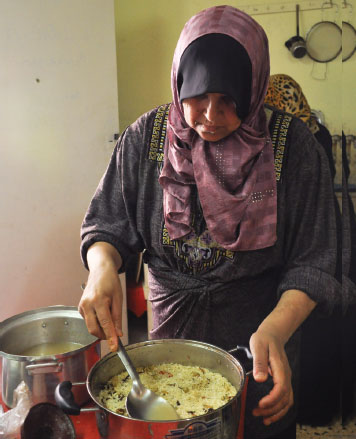
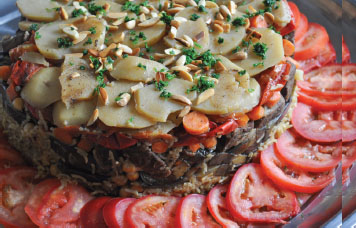
Serves 10–12
6 pounds (about 3 kilogram) assorted vegetables for stuffing: koosa squash (also known as grey zucchini or magda squash), bell peppers, baby eggplants, firm tomatoes, or Middle Eastern cucumbers
2 cups (390 grams) medium-grain rice or grade #3 bulgur
½ pound (250 grams) lean ground beef
1 onion, very finely chopped
½ cup (120 milliliters) olive oil
2 tomatoes, very finely diced
1 packed cup (25 grams) parsley, finely chopped
2½ teaspoons ground allspice
1 teaspoon ground cardamom
1 teaspoon black pepper
½ teaspoon ground nutmeg
3½ teaspoons salt
2–3 tomatoes (cut to size for plugging vegetables)
2 teaspoon dried mint
5 cloves garlic, crushed
2 hot green chiles, chopped
9 ounces (260 milliliters) tomato paste, diluted in 6 cups (1½ liters) boiling water
Wash and rinse the rice or bulgur several times. Soak it in 1 cup (235 milliliters) cold water for 15 minutes or until nearly absorbed. Do not strain.
Core the vegetables using a special squash corer (man’arit koosa) which can be easily obtained from a Middle Eastern market, or the tip of a long vegetable peeler, taking care not to pierce the skin. Core in slow, circular motions, as you twist your wrist. With each subsequent entry into the squash, remove a little more of the pulp on the inside walls and bottom of the squash, until you have a nearly empty cavity. Several gentle rotations in and out along the inside edges of the squash should do the trick. With eggplants, you will benefit from kneading them a few times back and forth under the palm of your hands before coring. Place the cored vegetables in a vat of salted water. Submerge the vegetables, making sure water has entered the insides, then shake them out and strain. This will help them retain their shape while cooking. Before stuffing, rinse and pat them dry.
In a large bowl, combine the meat with the damp rice and its soaking water, the olive oil, chopped onions, parsley, tomatoes, allspice, cardamom, black pepper, and nutmeg, along with 3 teaspoons of the salt. Mix well. If the stuffing appears crumbly and dry, add a couple of tablespoons of water to moisten it. With your hands, carefully fill each hollowed-out vegetable with this rice mix, leaving a little space (about 1 inch or 2½ centimeters) on the top for the rice to expand as it cooks. Plug the opening of each vegetable with a piece of tomato cut to size.
Gently set the stuffed vegetables in the bottom of a large pot, laying them neatly and snugly on their sides.
For the broth: In a mortar and pestle, crush the garlic with the remaining salt. In a small saucepan, bring the water, mixed with the tomato paste, to a boil. To this, add the chopped chile peppers and crushed garlic. Add mint only if you are not using eggplants. Pour this sauce over the vegetables. There should be enough liquid to completely submerge the vegetables. If there isn’t, add a bit more water. Close the pot tightly. Bring to a boil, then simmer, partially covered, for 30 minutes on medium-low heat.
Check the rice for doneness after 20 minutes.
Turn off the heat and let the vegetables rest in the pot for at least 20 minutes. Gently remove the vegetables from the sauce and arrange them on a serving platter. Serve the sauce alongside them.
Variation
Stuffed koosa can be prepared together with stuffed grape leaves (page 216). Omit the mint and hot peppers from the broth and invert the pot onto a platter when fully cooked and rested.

This is a dish best made in company. Coring vegetables can be onerous if done alone but is downright festive when many hands are at work together.
Some prefer to substitute medium-grain bulgur for the rice in this classic dish. A mix of the two grains can also be used.
Choose the smallest available squashes and very taut eggplants. Do not be tempted to substitute dark-green zucchini for the pale-skinned koosa: they tend to get too soft when boiled.

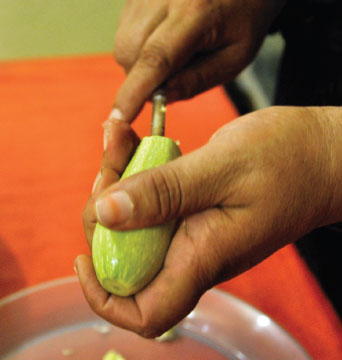


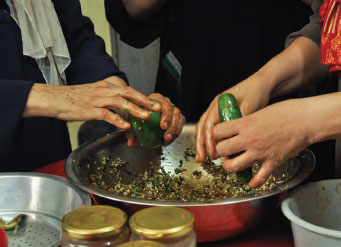


The El-Samouni name is a tragically famous one in Gaza: In one of the most internationally recognized and widely criticized incidents of the war on Gaza in 2008–09, the entire extended El-Samouni family was ordered into one house, which was then demolished. Forty-nine members of the family—mostly women and children—were killed.
Lulu wears her surname like an onerous medal; in the Zeitoun Cooperative’s kitchen, eyes are lowered in a meaningful pause after she is introduced. But the respect she commands is not only because of her family’s tragedy. She has a gravity of her own.
Zeitoun is a poor urban neighborhood that has been struck especially hard by the collapse of industrial employment; here there is no agricultural land to fall back on for subsistence. Lulu’s brother is one of those who lost his work and, like so many others in Gaza, succumbed to acute diabetes, leaving his wife and seven children in abject poverty. To keep the family afloat, Lulu began making and packaging sundried maftool to sell on the local market. With a ban on the export of most goods from Gaza, selling it abroad or marketing it via fair-trade organizations is not an option.
Lulu is unmarried and has no children, but her precarious little enterprise now supports a crowd of her siblings’ offspring. When we spoke to her, her dream was to be able to print labels for her product to market it at local stores, but the up-front cost of printing was more than she could come up with.

Serves 8–10
One 2 pound (850 grams) jar of grape leaves
2½ cups (490 grams) short-or medium-grain rice or a combination of rice and #3 bulgur
1 pound (450 grams) extra-lean ground beef
½ medium onion, very finely chopped
½ packed cup (12 grams) finely chopped parsley
1 tomato, very finely diced
¼ cup (60 milliliters) olive oil
2¾ teaspoons ground allspice
1 teaspoon ground cardamom
1 teaspoon black pepper
2½ teaspoons salt
¾ teaspoon ground nutmeg
2 tomatoes, thickly sliced
6 tablespoons tomato paste, diluted in 5–6 cups (1½ liters) hot water
Wash and rinse the rice or bulgur several times, then set aside to soak in 1 cup (235 milliliters) cold water for 15 minutes or until most of the water has been absorbed. Do not strain.
Combine the meat with the soaked rice and its soaking water, chopped onions, parsley, finely diced tomato, oil, allspice, cardamom, nutmeg, black pepper, and salt in a large bowl. Mix well.
Rinse the grape leaves well. Gently unfold them and spread them out on your work surface. Trim the stems and cut the larger leaves in half lengthwise, starting from the stem and going down the center seam. Place about 1 teaspoon of the rice stuffing at the edge of the leaf closest to the stem. (If you are using a cut leaf, turn so the cut edge is facing you, then place the stuffing near that edge.) Shape the stuffing into a small log at least ½ inch away from the frilly edges of the leaf. Roll the leaf once over the stuffing, then fold in the edges and roll again. Continue in this manner (rolling tightly, folding in, rolling tightly) until the leaf is fully rolled. Secure each roll by squeezing it gently with your hand. Reserve any torn or imperfect leaves.
Arrange an overlapping layer of sliced tomatoes in the bottom of a large pot. On top of this, arrange the stuffed grape leaves in a circular pattern like the spokes of a wheel, adding layers as the pot fills. When all the rolls are arranged, cover them with a layer of torn leaves.
In a large saucepan, bring the diluted tomato paste to a boil, adding more water if it appears to be too thick. Pour it over the grape leaves, then cover them with a heatproof flat plate (preferably a heavy one) to weigh them down. The tomato sauce should cover the grape leaves. If not, add water to compensate.
Cook on medium-high heat for 10 minutes. Reduce the heat to low and simmer gently, partially covered, for 40 minutes or until the water is absorbed. Test some rice from a sample grape leaf to see if it is cooked through. If the sauce has reduced and the rice is still not cooked through, add more water or chicken stock, ½ cup at a time, and cook until the rice is cooked through.
Remove from heat and let the pot rest for at least 15 minutes, covered. Carefully invert it onto serving platter (place a platter on top of the pot, then flip it all over in a quick motion). The grape leaves will form a compact and elegant mound.
Serve with yogurt or a salad of yogurt and cucumbers.
Variation
Instead of lining the bottom of the pot with tomatoes, use 1 pound (450 grams) of thinly sliced boneless steaks, pierced several times with a fork, pounded slightly with a kitchen mallet, and rubbed with a grated onion and ½ teaspoon each of allspice, salt, black pepper, and cardamom. This makes for a particularly lovely presentation once inverted and adds a delicious layer of flavor to the grape leaves.

Women joke that this dish takes hours to make and minutes to consume, but everyone loves it so much that somehow it is worthwhile anyway.
Throughout Palestine, tender grape leaves are picked in the spring and sold at public markets. Nothing tastes quite like these fresh leaves. If you can’t get fresh ones, the best substitutes are Orlando brand jarred grape leaves. Several varieties of vacuum-sealed Turkish leaves have recently become available in US markets as well. If the leaves tear easily, you know they are of poorer quality.
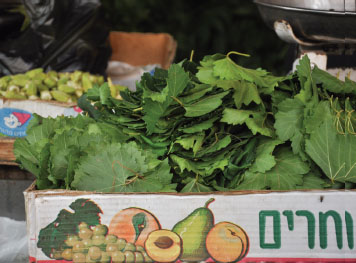
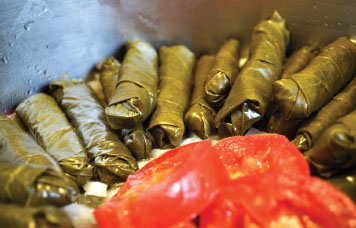

Serves 4–6
8–10 small eggplants, about 4 inches (10 centimeters) long
1 pound (450 grams) lean ground beef or lamb
1 medium onion, finely chopped
1 green chile pepper, finely chopped
1 teaspoon salt, more as needed
½ teaspoon black pepper
¼ teaspoon ground nutmeg
¼ teaspoon ground allspice
5 very ripe tomatoes
2 tablespoons pine nuts
Water
Olive oil
Preheat your oven to 350°F (180°C).
Peel the eggplants in alternating strips: Peel off one strip of skin, then leave a strip on, then peel another, such that the eggplant has longitudinal zebra stripes. Soak them in a cold bath of salty water for 20 minutes. Pat dry.
Sauté the finely chopped onion in 2 tablespoons of olive oil until translucent. Add the chile pepper, ground meat, salt, pepper, nutmeg, and allspice. Grate or blend 2 tomatoes and add them to the meat. Allow them to cook down over medium heat until nearly but not quite dry. In a separate pan, lightly fry the pine nuts in 1 tablespoon of olive oil, taking care not to burn them, then stir them into the meat and set it aside.
Grate or liquefy the remaining 3 tomatoes in a blender (or substitute a few tablespoons of tomato paste diluted in 2 cups or 473 milliliters of water). Set aside.
Pan-fry the eggplants in olive oil until they are browned on all sides. Allow to cool on a plate lined with paper towels. Once they are cool enough to handle, cut a lengthwise slit in each eggplant and stuff it with a few tablespoons of the meat mixture, depending on the size of the eggplant.
Arrange the stuffed eggplants in a baking tray and cover them with the grated or liquefied tomatoes. Add ¼ teaspoon of salt and enough water to submerge about ⅓ of the eggplant.
Bake for 45 minutes or until the eggplants are soft throughout (this will depend on their size). If they appear to be drying out, cover them with aluminum foil or adjust the liquid quantity.
Garnish with a sprinkling of chopped parsley and serve hot, with Ruz Imfalfal (page 206) and salad.

Its name meaning the “sovereign of stuffed things,” this classic dish is ideally made with eggplants that are very small, taut, and shiny. Larger eggplants will work, but the result is less delicate.
Though it was historically frowned upon for its strong flavor, an eggplant properly prepared is indeed the queen of vegetables, inspiring the tenth-century Syrian poet Kushajim to write, memorably, “My doctor makes ignorant fun of me for loving eggplant, but I will not give it up. Its flavor is like the saliva exchanged by lovers in kissing.”
The eggplant should be fried very hot so it doesn’t absorb too much oil, and should be given enough time in the oven to become quite soft.

Serves 8–10
1 compact head green Asian-variety cabbage (approximately 4–5 pounds/2 kilograms)
6–8 cups (approximately 2 liters) water or broth, as needed
20 cloves garlic (yes, 20 cloves)
2½ cups (490 grams) medium-grain rice, washed well
½ pound (225 grams) lean ground beef
3 green chiles, thinly sliced
3 teaspoons ground cumin
2 teaspoons allspice
½ teaspoon cardamom
½ teaspoon black pepper
¼ teaspoon nutmeg
Juice of 3–4 lemons
1 tablespoon dried mint leaves
½ cup (120 milliliters) olive oil
Salt
Wash and rinse the rice several times, then soak it in 2 cups of cold water (470 milliliters) and set aside.
Trim the cabbage of any rough exterior leaves that are not compactly attached to the main head, then submerge the head in water or broth with 1 teaspoon each of cumin and salt, and boil it whole for 10 to 15 minutes or until the leaves are tender. Carefully remove it from the water using tongs or wooden spoons. Leave the water simmering on the stovetop. You might also try microwaving the entire head of cabbage to moisten and loosen the leaves.
Cool the cabbage by running it under cold water, then separate the individual leaves, starting from the outside. If you can no longer peel away leaves without breaking them, return the cabbage to the pot of water and boil it for a few more minutes. Repeat until all the larger leaves are separated and you reach the heart of the cabbage. Reserve this: It is known as jajit il malfoof—the chicken of the cabbage—and can be stuffed along with rest of the leaves. It was Laila’s favorite as a child!
Prepare the stuffing: In a mortar and pestle, crush 10 of the garlic cloves, a few cloves at a time, with ½ teaspoon of salt, until well mashed. Strain the rice, then combine it with the olive oil, ground meat, 1 teaspoon of cumin, mashed garlic, cardamom, allspice, black pepper, 2½ teaspoons of salt, and nutmeg.
Spread each cabbage leaf flat. Cut the large leaves in half vertically, removing any hard veins with a knife. Reserve the veins and broken bits of cabbage.
Stuff the rolls: Place approximately 1 tablespoon of stuffing inside each flattened cabbage leaf and spread it into a thin log. Roll the cabbage leaf closed over the stuffing. There is no need to tuck the ends of the cabbage leaf inside—it will seal itself. The rolls needn’t be uniform or even tightly rolled: Cabbage leaves hold their shape surprisingly well during cooking. Squeeze each roll gently to strain off excess moisture. Finally, put several spoonfuls of stuffing inside the cabbage heart and squeeze it closed (no need to roll it).
Roughly slice the remaining garlic cloves. Line the base of the pot with the reserved hard cabbage bits, then arrange the stuffed cabbage leaves over them, scattering chopped chiles and sliced garlic between each layer.
Pour the water in which the cabbage was initially boiled over the stuffed leaves, just enough to cover them. Boil it for 5 minutes, then reduce the heat to medium-low and cover the leaves with a heavy heat-proof plate to weigh them down. Simmer for approximately 40 minutes or until the rice is cooked through. Combine the lemon juice and dried mint, then pour them over the cabbage rolls. Remove the pan from the heat and let it rest, covered, for 15 minutes.
Carefully drain any excess liquid from the pot, then invert the stuffed rolls onto a round platter as you would maqlooba.
Serve with yogurt or a salad of cucumbers, yogurt, and mint.

Large, sweet cabbages are grown in patches all along Gaza’s main coastal road—an area once slated to become the seaport—and sold at roadside stalls. They are exquisite stuffed, rolled, and simmered in a garlicky broth.
Look for cabbage with tightly packed, moist-looking leaves: The finer and more tender the leaves, the better. In the United States, Asian cabbage varieties work best. If you have extra stuffing, roll a few lettuce leaves to finish it off.


This book documents life within Gaza. But what of all those Palestinians, including many from the Gaza district, who live on the outside? In Seeking Palestine, Raja Shehadeh writes, “Palestine evokes a particular obligation of belonging in its far-flung ‘inhabitants,’ for whom insistent memory becomes a mode of habitation.” There are at least 12 million Palestinians living in diaspora, more than are living within the land itself. Half of these live in the Arab world, whether in permanent refugee camps or as long-term stateless residents in other countries. They have lived through various waves of exile, impelled by ethnic cleansings or discriminatory rules and regulations meant to rid the land of its native inhabitants by way of “indirect transfer.” Then there are those who chose to migrate voluntarily, for economic reasons or, in the case of Abu Ameen, for “peace of mind.”
We meet Abu Ameen in his home in Edgewater, Maryland, a serene little bayside town, his adopted home of thirty-some years. We have come to document his purported prowess in preparing all manner of Gazan meals, with hacks that include using a power drill to core the stiff, stubborn red carrot.
But Abu Ameen refuses to budge, citing social impropriety. At 84 years old, it seems he just doesn’t feel like cooking today. But talking? Well, that he can do plenty of.
He dives right in, detailing the various substitutes one could use for red carrots, his signature dish. “Fat, firm orange or even white carrots will do,” he insists, adding the following caveat: “But don’t ever be tempted to shred or layer the carrots and stuffing like a casserole—that’s just going too far! It’s like a friend of mine whose wife couldn’t cook and so she decided it would be easier to deconstruct malfoof, cabbage rolls, and cook them in a baking pan. Abominable! A travesty!” He shakes his head in disbelief.
Where one draws this murky line and how one determines whether and when it has been breached is not entirely clear, but in Abu Ameen’s mind, there’s no question: You simply can’t make a cabbage lasagna and call it malfoof.
Abu Ameen’s father, Nazmi, was a headmaster who taught at various schools throughout historic Palestine, eventually settling in Gaza City to ensure an education for his children. Like his father before him, Abu Ameen chose to migrate, this time westward, in the early eighties to join his two brothers and live a more “orderly and calm life.”
He shares the story of his travel to America from Palestine, one that still has him in stitches decades later:
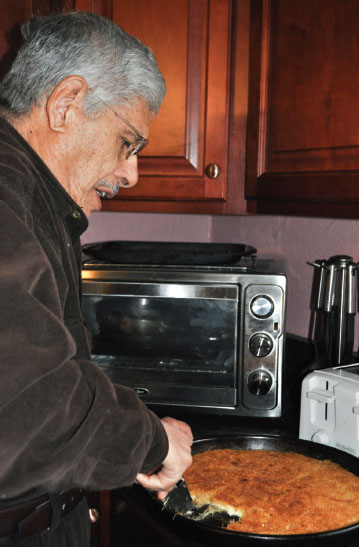
It was the day that forty Jewish extremists tried to break into the Al-Aqsa Mosque in 1979. I was getting ready to travel and the Israelis had imposed a curfew in Gaza. We had picked olives and needed to take them to the press, but due to the curfew, we couldn’t. Instead, we cracked the olives, then placed them in a large basin and extracted the oil the old-fashioned way—by adding hot water to the olives and waiting for the oil to rise to the surface, zait tfah. It’s something my mom picked up during her time living in Nablus. I took several bottles with me on the plane. Little did I know the bottles weren’t properly sealed, and during the plane ride, due to cabin air pressure, the bottles opened and slowed dripped out from the overhead compartment onto the head of the bald guy seated in front of me. I pretended not to know what was going on, and when the worst was over, I went to search for the olives, only to find that the stewards had disposed of them in in the trash. A calamity! I can’t forget those olives and oil and all the hard work we put into cracking them to this day! Allah yirhamhum!
Unlike many other Palestinians abroad whose residency rights were revoked or denied by Israel, Abu Ameen was able to visit Gaza regularly until the near-hermetic border closure of recent years rendered the journey impossible.
What does he miss the most?
“Friends. But most of mine have moved on from this life…. It’s not so much about missing things—it’s about adapting and it’s about memories.”
For Abu Ameen, as for so many immigrants, cooking became the means of retaining and passing those memories on to the next generation. For Palestinians, this legacy takes on heightened significance and a perceived sense of urgency: a last straw to clutch onto before all that was known is erased forever. Abu Ameen considers it a blessing and a reminder.
Outside in his little yard, he picks a leaf of common sorrel growing in the patchy spring grass. “Look! Hamasees!” Home is always elsewhere, and right under our feet.